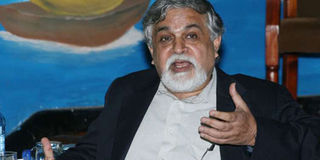The in-between world of writer MG Vassanji

Writer M.G Vassanji speaking to pupils of Aga Khan academy on January 24, 2013. Kenyan-born Vassanji’s preoccupation with the histories of minorities dominate the new book. This book comes at a time when the East African region is grappling with the implications of competing narratives of nationhood. PHOTO | FILE
What you need to know:
- The world that Vassanji writes of has unequal and largely unfair group engagement terms. For ‘victims’, it is important to persistently declare one’s presence and reject the easy route of accepting minority status.
- Sayed’s ‘Introduction: Writing History, Writing Diaspora: the In-Between World of M.G. Vassanji’ borrows from MG’s The In-Between World of Vikram Lall, to survey MG’s corpus.
- Highlighting the thread of history that ties the writings together and to one author, Sayed also shows the theoretical tools that have been readily deployed to unpack MG’s usually layered and nuanced readings of his subjects.
East Africa’s most celebrated author of Asian ancestry, M.G. Vassanji, has attracted a new book of essays. Claimed by Canada and Tanzania, Kenyan-born Vassanji’s preoccupation with the histories of minorities dominate the new book. This book comes at a time when the East African region is grappling with the implications of competing narratives of nationhood.
M.G. Vassanji: Essays on His Works (2014), edited by Asma Sayed, includes ‘So As Not to Die’, Vassanji’s own essay initially delivered as a keynote address at McGill University in 2010.
Vassanji’s lecture answers the question of the predominance of history in his fictional works. If other contributors to the book grapple with the question of different histories in his fiction, Vassanji’s lecture affirms the centrality of history as both context and co-text to his writings.
The world that Vassanji writes of has unequal and largely unfair group engagement terms. For ‘victims’, it is important to persistently declare one’s presence and reject the easy route of accepting minority status. In this vein, Vassanji’s essay highlights the necessity of pronouncing Asian identities outside the context of minority / dominant binaries, but see these as attempts at gaining a grip on the fluid understanding ourselves.
SPATIAL REPRESENTATION
Thus, ‘if you don’t let others know about you, they discover you on their own terms: as backward and savage, as dying and diseased, as not having culture and being joyless’ (321). Vassanji views the necessity of history as a subversive tool that aims at turning preconceptions and stereotypes on their heads. For this reason, ‘history becomes a battleground’ (318).
Other contributors to this important book illuminate different spots in this ‘battleground’, including the social and cultural implications of cosmopolitanism to migrant identities (Anne Cottier), Vassanji’s philosophising in essays (Jonathan Hart), and the socio-political interpretations of geographical spaces (Jonathan Rollins, Warris Vianni, and Nancy Batty). Theory, as a product of historical reflections on interpretation, is also respectively dealt with by Amin Malak and by Sayed.
Sayed’s ‘Introduction: Writing History, Writing Diaspora: the In-Between World of M.G. Vassanji’ borrows from MG’s The In-Between World of Vikram Lall, to survey MG’s corpus.
Highlighting the thread of history that ties the writings together and to one author, Sayed also shows the theoretical tools that have been readily deployed to unpack MG’s usually layered and nuanced readings of his subjects. Anne Cottier follows with ‘Loss, Belonging and the Vagaries of Migration: Cosmopolitanism in M.G. Vassanji’s The Assassin’s Song.’
This essay title, while a tad mouth-filling, points to the key concerns that one can read in virtually all of MG’s works. Although, admittedly, there are only a handful of critical responses to The Assassin’s Song, I thought the critic took on more than a book chapter can adequately capture. Loss, belonging and cosmopolitanism are each extensive and intensive subjects that have been intensely presented in the novel, and a focus on one or two of these would have created more room for textual analysis.
Jonathan Hart’s ‘M.G. Vassanji and the Essay of Life’ not only targets the essay, a genre of Vassanji’s writing that hardly invites critical responses, but does so by surfacing a remarkably close stylistic analysis that shows the close proximity between Vassanji’s subject areas and stylistic choices.
Importantly, Hart shows how Vassanji deploys distancing irony to make profound statements regarding his major themes in his essays. By analysing Vassanji’s artistic use of conditionals, passive and active constructions appropriately, Hart emphasises Vassanji’s ingenuity in manipulating form even when dealing with content.
Hart’s position is pursued differently by Jonathan Rollins’ ‘Picturing Canada: Narratives of Home and the (Trans-)National Imaginary in the Work of M.G. Vassanji’, an essay that mobilises diverse theoretical concepts and their implications to highlight the intersection between Tanzanian immigrants in Canada and the dominant spatial representations of the new country that Vassanji, in No New Land, designates ‘a place to lay down your head’ (34, Rollins 109).
POTENTIAL VICTIMS
Accordingly, Canada, like Africa, has for long been known for its vast emptiness – implying a subtle invitation to visitors to come, occupy and open it up – but, unlike Africa, it occupies traditional American imaginaries as a land where cold winds endlessly blow.
Vassanji, in borrowing these tropes in No New Land, as Rollins suggests, dramatises ‘the emptiness of Canada (… as) an emotional emptiness and detachment’ (129), thus using an extended metaphor to capture not just ‘a hostile natural environment’ but also a ‘hostile social environment’ (141).
The point is that we are all potential victims of (mis)representation, and that our sociology could be rooted to our geography, and that questioning one may lead us to a better understanding of the other.
All these are notable for their ‘freshness’, while others, like essays by Amin Malak ‘Ambivalent Affiliations and the Postcolonial Condition: The Fiction of M.G. Vassanji’, have been around. Overall, this is a worthwhile book with well written essays that should attract not just scholars of M.G. Vassanji’s writings, but those in the wider field of postcolonial, area and cultural studies.





